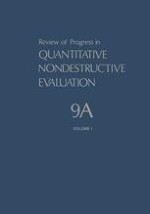This volume (Parts A and B) contains the edited papers presented at the annual Review of Progress in Quantitative Nondestructive Evaluation held at Bowdoin College, Brunswick, ME on July 24-28, 1989. The Review was organized by the Center for Advanced NDE at the Ames Laboratory of the U. S. Department of Energy, in cooperation with the Office of Basic Energy Sciences, USDOE, and the Materials Laboratory at Wright-Patterson Air Force Base. The statistics for the 1989 Review of Progress in QNDE include a total of over 460 participants from the U. S. and nine foreign countries who presented some 325 papers. Over the years this conference has grown into one of the largest, most significant gatherings of NDE researchers and engineers in the world. The meeting was divided into 35 sessions, with as many as four sessions running concurrently, and covering all stages of NDE development from basic research investigations to early engineering applications and all methods of inspection science from ultrasonics to x-ray tomography. The Editors have organized the papers in the Proceedings according to topical subject headings, rather than in the original order of presentation. This rearrangement yields a more user-friendly reference work and follows a pattern now familiar to regular attendees of the Review. Some changes in the headings and their subcategories have been introduced to accommodate dynamic evolution of the field, as we observe it.
